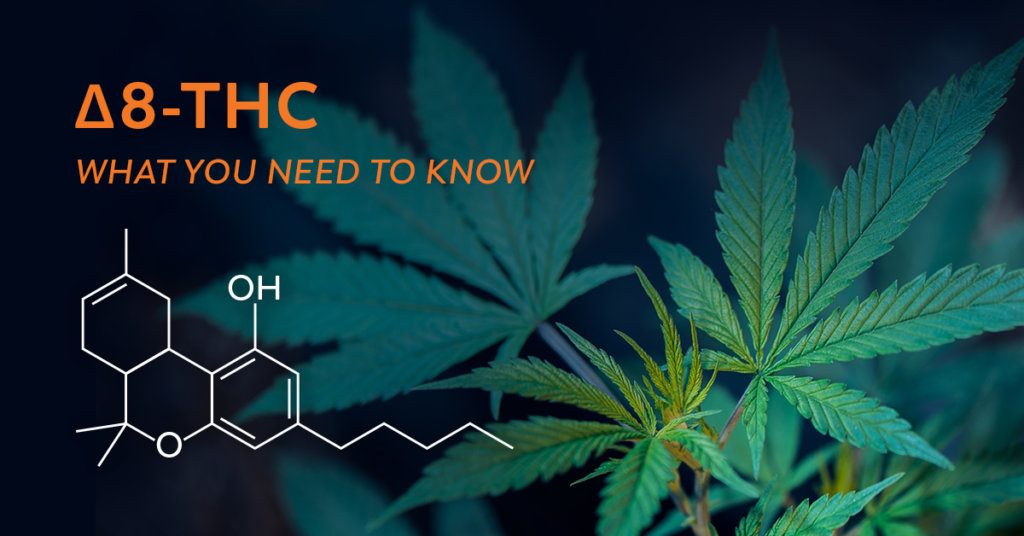
The cannabis plant contains hundreds of therapeutic biomolecules, including over 100 cannabinoids like THC and CBD. Within the cannabinoids, there are many analogs and isomers for each type—small differences that have big implications and real-world consequences. An extra carbon molecule or a double bond in a different position completely changes how a given molecule will interact with the body and with other cannabinoids and terpenes. Delta-8 THC is one such analog of the more familiar delta-9 THC. With a double bond on the eighth carbon atom instead of the ninth, delta-8 THC functions similarly to delta-9 THC. But other than being significantly less psychoactive, the science is still out on what that means to patients.1

Cannabinoid Analogs
For perspective, let’s look at some THC analogs that feature small differences with large consequences:
Like most of the cannabinoids, THC has an acidic version, THCA, which is identical but for a small attached acid that’s cleaved off when it’s decarboxylated. Decarboxylation is a chemical reaction caused by heat or time that removes an acidic carboxyl group and releases carbon dioxide. Until decarboxylation, the molecule is not psychoactive, so consuming THCA won’t give patients THC’s characteristic high.

When THC or other cannabinoids are synthesized from precursor CBGV instead of CBG, they become varin cannabinoids (ie THCV, CBDV). Varin cannabinoids have two fewer carbons in their tail for a grand total of three. Having a three-carbon tail versus a five-carbon tail means that the varin cannabinoids have a harder time binding to cannabinoid receptors in the body, ensuring that THCV is not as potent as its THC analog. On the other hand, the recently isolated and identified THCP has seven carbon atoms in the tail, giving it a more potent binding site, and likely the reason researchers found it to be 33 times as active as THC2. Extremely small changes in biochemistry have profound effects on how substances work in the body.

Delta-8 THC possesses exciting potential for helping patients with pain, inflammation, and nausea—with significantly less psychoactivity than delta-9 THC. Whether there is a corresponding decrease in efficacy with less psychoactivity has yet to be established, though it seems likely. Everybody with an eye towards the future in the cannabis space is keeping a close watch on delta-8 THC and is cheering for the eventual success of any cannabinoid as a therapeutic superstar.
A Limited Understanding of Δ8-THC
One hurdle in the understanding of delta-8 THC is the same hurdle faced by all other minor cannabinoids. A dearth of research means that primary sources on the efficacy of delta-8 THC are few and far between. A single clinical study in 1995 showed it to be a remarkably effective anti-emetic for the eight children in the trial.3 While this is fantastic news, it is one of the only studies to feature humans, and a sample size of eight juveniles does not constitute a solid framework of research.
Other studies researching delta-8 THC in vivo (in a living organism) use rats and mice as study organisms to demonstrate delta-8 THC’s capabilities as an analgesic, anti-inflammatory, anxiolytic, and neuroprotectant in a variety of conditions.4,5,6,7 However, another study shows that delta-8 THC reacts differently in humans than in rodents, causing bradycardia (slowed heart rate) in rodents, while increased heart rate in humans.8 So, while delta-8 THC and other minor cannabinoids show real promise in scientific studies, it is only prudent for the cannabis industry to proceed with caution and push for more clinical research and human trials before making claims or selling products to vulnerable patients.
A Natural Distinction
It is true that delta-8 THC is a natural product of cannabis, and humans have been consuming it for centuries. It is without a doubt at least an occasional player in the Entourage Effect, and hasn’t been associated with significant negative effects when ingested at low levels. It is important to remember, though, that in most dried cannabis flower, delta-8 THC is undetectable, and for the 1% of cannabis samples that contain enough to register, there are only trace amounts. Patients are exposed only to extremely low levels of delta-8 THC in the cannabis plant.
Since delta-8 THC is naturally present in cannabis only at minute concentrations, production requires more than simple extraction. For such a minor cannabinoid to present at therapeutic levels, cannabis must undergo extensive processing with chemicals such as acetic acid and bleach used to convert CBD into delta-8 THC. Since delta-8 THC does occur naturally, it is often marketed as a natural substance, but lab-made delta-8 THC (and the residual chemicals from its derivation) are a far cry from anything you’ll find naturally in the plant.
Even if we are to assume that delta-8 THC is safe to consume, we cannot make that assumption about other chemicals that may be in the product. California lab, InfiniteCal, ran over 2,000 delta-8 THC samples through chromatographic testing in 2020. Of those samples, less than one percent (that’s less than 20 samples) tested as pure delta-8 THC. The vast majority showed chromatographic peaks of unidentified substances in the samples.11 Without manufacturing and clean-up regulations or testing parameters in place, there is nothing to ensure that patients and consumers are getting a safe, let alone effective, product. When more than 99% of products have unidentifiable substances in them, and there is no testing standard to hold manufacturers to, it is in the best interest of the consumer to exercise extreme caution when purchasing these products. Add into the equation the proliferation of vape cartridges containing delta-8 THC and possibly other unknown substances, and you have a tinderbox of hazardous potentiality.
Does Less Psychoactive Mean Less Effective?
One of the most intriguing properties of delta-8 THC is its ability to work like delta-9 THC, without the same level of psychoactivity. Based almost entirely on anecdotal evidence, estimates of exactly how psychoactive it is vary widely, from 3% to 67% the psychoactivity of delta-9 THC.1,9,10 The mechanisms of action are not well-studied, but what research has been done has shown them to have very similar pharmacodynamics and pharmacokinetics to delta-9 THC. What this means is that it is working in the same way, on the same receptors—only 3%-67% less effectively. So while delta-8 THC is less psychoactive than delta-9 THC, that is likely simply because it is less effective across the board.
Is Δ8-THC Legal?
Thanks to its extremely low occurrence in nature, delta-8 THC inhabits a legal grey area. It is listed by the DEA (along with THC, delta-9 THC, Dronabinol, “and others”) as a Tetrahydrocannabinol, which is a Schedule I controlled substance. However, in August of 2020, the DEA implemented an interim ruling to modify the code of regulations to add language stating that the “definition of ‘Tetrahydrocannabinols’ does not include ‘any material, compound, mixture, or preparation that falls within the definition of hemp set forth in 7 U.S.C. 1639o.” The definition of hemp that they are referencing specifically cites hemp as Cannabis sativa with a delta-9 THC concentration of less than 0.3%. By this definition, if the substance has over 0.3% delta-9 THC, any delta-8 THC present is a Schedule I drug, yet if the substance has less than 0.3% delta-9 THC, even high concentrations of delta-8 THC are not controlled.
So, why is Δ8-THC suddenly so popular?
First of all, most manufacturers are synthesizing it from CBD. With the influx of hemp biomass in 2020 and plummeting prices across the market, that means it can be made at a fraction of the cost of growing medical cannabis and extracting delta-9 THC. Compared to delta-8 THC, research on CBD is plentiful and promising. Study after study shows its many benefits, and its mechanisms of action are becoming clearer as the evidence mounts. CBD, however, is ubiquitous these days, and it is not psychoactive. It’s easy to see why producers might get excited about a way to turn a surplus of CBD oil into a slightly psychoactive (and thus more expensive) product with less legislative oversight than its more effective analog.
While it is exciting to see where innovation and research into delta-8 THC will lead us, many are wary of derived substances that are not well researched, tested, or regulated. Skeptics are right to question the use of a derivative process that turns a safe and effective molecule like CBD into a poorly understood analog of THC. Utah’s patients deserve naturally-derived delta-9 THC that works effectively. Until there is a larger body of evidence proving that delta-8 THC is safe and until all products are tested to ensure they are free of any residual chemicals, it is hard to see the benefit to the patient to settle for a derived molecule whose main selling point is not being as effective as delta-9 THC.
Innovation in the cannabis space is moving at breakneck speed, and we’re excited to see the potential of delta-8 THC and other minor cannabinoids. Even more important, though, is an informed patient population empowered to make decisions between natural versus derived cannabinoids, and a legislation that ensures the Utah cannabis market grows and flourishes in a way that supports a healthy industry and educated public.
Work Cited
- National Cancer Institute. (2011). NCI drug dictionary.
- Citti, C., Linciano, P., Russo, F., Luongo, L., Iannotta, M., Maione, S., … & Gigli, G. (2019). A novel phytocannabinoid isolated from Cannabis sativa L. with an in vivo cannabimimetic activity higher than Δ 9-tetrahydrocannabinol: Δ 9-Tetrahydrocannabiphorol. Scientific reports, 9(1), 1-13.
- Abrahamov, A., Abrahamov, A., & Mechoulam, R. (1995). An efficient new cannabinoid antiemetic in pediatric oncology. Life sciences, 56(23-24), 2097-2102.
- Adams, M. D., Earnhardt, J. T., Dewey, W. L., & Harris, L. S. (1976). Vasoconstrictor actions of delta8- and delta9-tetrahydrocannabinol in the rat. The Journal of pharmacology and experimental therapeutics, 196(3), 649–656.
- Thapa, D., Cairns, E. A., Szczesniak, A. M., Toguri, J. T., Caldwell, M. D., & Kelly, M. (2018). The Cannabinoids Δ8THC, CBD, and HU-308 Act via Distinct Receptors to Reduce Corneal Pain and Inflammation. Cannabis and cannabinoid research, 3(1), 11–20. https://doi.org/10.1089/can.2017.0041
- Hine, B., Toreelio, M., & Gershon, S. (1977). Analgesic, heart rate, and temperature effects of delta8-THC during acute and chronic administration to conscious rats. Pharmacology, 15(1), 63–72.
- Sjödén, P. O., Järbe, T. U., & Henriksson, B. G. (1973). Influence of tetrahydrocannabinols (Δ8-THC and Δ9-THC) on body weight, food, and water intake in rats. Pharmacology Biochemistry and Behavior, 1(4), 395-399.
- Sultan, S. R., Millar, S. A., O’Sullivan, S. E., & England, T. J. (2018). A Systematic Review and Meta-Analysis of the In Vivo Haemodynamic Effects of Δ⁸-Tetrahydrocannabinol. Pharmaceuticals (Basel, Switzerland), 11(1), 13. https://doi.org/10.3390/ph11010013
- Webster et al. (2008) United States Patent No. 7,399,872
- Hollister, L. E., & Gillespie, H. K. (1973). Delta‐8‐and delta‐9‐tetrahydrocannabinol; Comparison in man by oral and intravenous administration. Clinical Pharmacology & Therapeutics, 14(3), 353-357.
- https://www.marijuanatimes.org/california-lab-offers-cautionary-notes-regarding-delta-8-thc/

thank you for your continued work on an important subject; our mental and physical condition. We think of you all the time. Are you in Castle Valley or ?